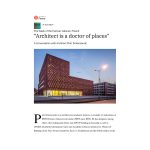About the architecture and peripheral location for Versopolis Poetry.
more: here
One could say that you?re a specialist in provincial architecture. For the last twenty years, you?ve been designing architecture out of Koszalin ? yet not just for medium-sized cities like the one you?re based in, but also for regional metropolises such as Katowice.
I wouldn?t use the word ?provincial? in this context ? to me, provincialism is a state of mind, a certain level of consciousness rather than a fact dictated by geographical location. I founded my first studio in Poland with a view to working in a smaller city. I wanted to have more time for architecture to be able to do it better. To not lose time on unnecessary things like commuting to and from work or going to other places we have to visit every day. It was important to have time for local projects and nationwide architectural competitions. One can work a little differently in the periphery. Time passes somewhat slower. Now, of course, you can do all that in a large city if you live and work within a single district, where you also have access to the kind of architectural culture that was basically non-existent when I was starting out in Poland. It just wasn?t there twenty years ago. Whether we talk about Warsaw, Gdańsk or Koszalin, it was all just emerging and barely there at all.
What do you mean by architectural culture?
To me, architectural culture is a type of atmosphere that fosters an exchange of views, a presentation of creative attitudes. Exhibitions on architecture, professional literature and magazines, architects coming with guest lectures? Twenty years ago the level was equal everywhere or, to put it bluntly, none of that was happening, whether you were in the centre or the periphery. Even prestigious schools and universities did not invite any guest lecturers. On many occasions, that had to do with our sense of inferiority, a fear that such guests would make us look bad in the eyes of students. Things are different now. More and more people care about architecture, because it defines the space we leave in, and ? as society ? we started paying attention to that about that a while ago. In small towns this architectural culture is still developing very slowly, but large cities are already hosting guest architects from all over the world. There are exhibitions, debates organised by various bodies. Architectural pavilions are cropping up, meeting places where one can talk about architecture. I see a clear association here with the emergence and consolidation of the civil society. There are many new organisations – foundations, associations that deal with architecture and organise a lot of events related to it. Others that have existed for a long time began to act more courageously and intensely through the inflow of young people. Multinational companies selling their products in Poland began to base their marketing on the promotion of architecture. A lot has changed in that respect. The cultural offer in terms of architecture is much broader in large cities. In the periphery, though, even now not a lot is happening.
We are having this conversation in Szczecin, where there?s quite a lot going on, but it?s still incomparable to the offer we?ve got in Warsaw. And in Berlin, which is just round the corner, you can pick and choose between architectural events basically every day. So perhaps it is a question of geography after all?
In the case of Berlin, the important thing is that it?s not just a German, but a European metropolis. The point of reference changes. This peripheral location, provincialism depends on the point of reference. Is Koszalin a peripheral city with respect to, say, Wrocław? Probably. And is Wrocław a provincial city with respect to Berlin? I guess. Is Berlin provincial with respect to New York? Maybe. It all depends on the reference point.
When you?re looking at the last 20-25 years in Polish architecture, do you see any changes in this centre-periphery dichotomy?
Architecture is getting better and better, for one simple reason. There are more and more construction projects, and Polish architects have an opportunity to learn from their mistakes in subsequent designs. When you design your fifth or sixth office building, if you?re smart, you try to constantly improve. We have really great studios designing very good commercial architecture that we don?t have to be ashamed of internationally. I don?t see commercial architecture as a derogatory term, quite the contrary ? this is the type of architecture that?s being built most frequently and has a considerable influence on what our cities look like.
These changes aren?t as visible or huge in the periphery, though.
At the moment, the largest share of construction projects are office and residential buildings. In the periphery, the demand for office buildings is much lower and residential projects are governed by minimum investment costs. Architects from smaller centres have fewer opportunities to see their designs come to life, as there?s just not that much architecture being built. Only a realised project enables you to learn. The boom we?ve seen for a while mostly concerns large cities. It?s cumulated there. This is where architects can work and improve their quality. Of course, some local projects are also done by architects from the centre. Most often because the investor is from the centre and picks the architect he usually works with. At other times, local investors may pick an architect from the metropolis hoping to make their project more prestigious.
This mechanism is also present in metropolises. A world-famous architectural studio means great accolade for the project and everyone talking about it.
Even in Poland you already have star architects employed for large development projects ? mostly so that the author may make the project famous. It?s also a way of influencing public opinion. There is this unwritten assumption that if you?ve got a great architect, you also have a great project. Most of these projects are strictly commercial and need not be good for the given location. They can be made everywhere. We?re still electrified by news that, say, MVRDV is going to make a building in Wrocław. This is such a big thing that hardly anyone pays attention to the quality of the project itself. Suffice to find out that BIG is going to make its first building in Poland and what we do is at most glance at the visuals without analysing the project in depth. And locality is important. Pomerania is completely different to Masovia, Lesser Poland or Podlachia. These are entirely distinct areas, shaped in entirely separate cultures, which evolved along very dissimilar paths and were subjected to various influences. One of architecture?s enormous values is that it can reach for this locality. This is why architecture can differ, it doesn?t have to match structures made in the UK or Germany. If we analyse this locality intensely enough, it can bring new developments for architecture. Switzerland is the best example here. On the one hand, Swiss architecture is global, well-known and appreciated all over the world, on the other, it is very much informed by the locality it is rooted in.
What you say makes me think about your definition of the architect?s role. You say that an architect is a doctor of places. I?m inclined to believe that it?s much easier to treat such peripheral places ? and it?s the periphery that needs such medicine men the most.
Large cities are repaired much faster in Poland. They are running out of plots, empty places and holes to be developed. The construction activity around local centres intensifies so the cities become denser ? and that?s what it?s all about.
When you work locally, you have this opportunity, this advantage of knowing the place where you live and working with a context you may know better than others. Of course, this is not a decisive advantage. Merely a few extra points at the start of project work. But someone coming from a big city and wanting to do good, context-based architecture in the provinces is still able to do it, with the right level of involvement in getting to know the place. That?s something we?ve done in Katowice as architects from the seaside designing the Academic Library in Silesia. We made a conscious attempt to discover this place and adapt to the context. I don?t mean the obvious geometric context, but the multi-layered context that goes beyond the geometry of the place. Enabling a place to become what it?s always wanted to be.
I think there?s one more thing that distinguishes metropolises, the centre from the provinces and periphery. The bigger the city, the more aware its authorities are of the promotional importance of architecture. Szczecin, for example, already knows that. The number of European awards received by the Szczecin Philharmonic or the ?Przełomy? Dialogue Centre has probably surprised even the authorities.
Yes, that?s true. My only fear is the idea of creating buildings that are meant to be iconic. A building may become iconic, but you can?t design an icon. This approach is a complete reversal of the process. A building becomes an icon because it is perfectly fir for purpose, the architecture is overwhelming and adapted to the given place. This is most frequently the case if projects are implemented following a competition evaluated by a professional jury. In Szczecin, both the Philharmonic and the ?Przełomy? Dialogue Centre were built following international competitions. Unfortunately, this doesn?t really happen outside large cities. Elsewhere, most municipal development projects are created following a public tender, where the overriding value is the lowest price and not the highest quality of architecture.
For twenty years, you?ve been based in Koszalin, a city with a population of 100,000, doing projects all over Poland. Now you?ve opened an additional studio in Szczecin. Why the change?
Limits of the periphery. I wanted to branch out the ANALOG studio into a separate unit that could focus only on competition designs. I wanted to work with young, talented people. Yet it would be hard to persuade them to even temporarily move to a city like Koszalin, if only because of its isolation from the rest of the country in terms of transportation. That,s why I opted for the nearby centre, Szczecin ? a city with amazing potential that unfortunately still waits to be unlocked. Szczecin is a centre/periphery hybrid, a fact that?s best exemplified by a consent to mediocrity: ?for Szczecin it?s enough, it doesn?t have to be any better? ? words you often hear in Koszalin too.




